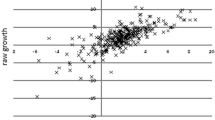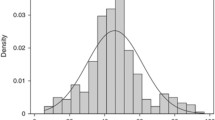Abstract
It is widely believed that U.S. presidential elections represent a referendum on the policies and achievements of the incumbent party. Pioneering studies by Kramer (1971) and Fair (1978, Fair 1982, Fair 1988, Fair 1996) found empirical support for this proposition; specifically, both concluded that more rapid growth of real output produced gains for the party of the incumbent president. Following Kramer and Fair, others have investigated empirical links between election outcomes and economic performance using a variety of techniques, specifications, and data sets. These empirical relationships are often referred to as “vote functions.”
Access this chapter
Tax calculation will be finalised at checkout
Purchases are for personal use only
Similar content being viewed by others
References
Abramowitz, A. (1992). “An improved model for predicting presidential outcomes.” PS: Political Science and Politics, 21: 843–847.
Abramowitz, A. (1996). “Bill and Al’s excellent adventure: forecasting the 1996 presidential election.” American Politics Quarterly, 24: 434–442.
Beck, N. (2000). “Evaluating forecasts and forecasting modles of the 1996 presidential election,” in J. Campbell and J. Garand (eds.) Before the Vote: Forecasting American National Elections. Thousand Oaks, CA: Sage Publications, pp. 161–168.
Brown, L. and Chappell, H. (1999) Forecasting presidential elections using history and polls. International Journal of Forecasting, 15: 127–135.
Campbell, J. (1996). “Polls and votes: the trial heat presidential election forecasting model, certainty, and political campaigns.” American Politics Quarterly, 24: 408–433.
Campbell, J. and Wink, K. (1992) “Trial-heat forecasts of the presidential vote.” American Politics Quarterly, 18: 251–269.
Erikson, R. and Wlezien, C. (1996). “Temporal horizons and presidential election forecasts.” American Politics Quarterly, 24: 492–505.
Fair, R. (1978). “The effect of economic events on votes for president.” Review of Economics and Statistics, 60: 159–173.
Fair, R. (1982). “The effect of economic events on votes for president: 1980 results.” Review of Economics and Statistics, 64: 322–325.
Fair, R. (1988). “The effect of economic events on votes for president: 1984 update.” Political Behavior, 10: 168–179.
Fair, R. (1996). “Econometrics and presidential elections.” The Journal of Economic Perspectives, 3: 89–102.
Forsythe, R., Nelson, F., Neumann, G., and Wright, J. (1992). “Anatomy of an Experimental Political Stock Market.” American Economic Review, 82:1142–1161.
Gelman, A. and King, G. (1993). “Why are American presidential election campaign polls so variable when votes are so predictable?” British Journal of Political Science, 23: 409–451.
Hibbs, D. (2000). “Bread and peace voting in U.S. presidential elections.” Public Choice, 104: 149–180.
Holbrook, T. (1991). “Reading the political tea leaves: a forecasting model of contemporary presidential elections.” American Politics Quarterly, 24: 434–442.
Kramer, G. (1971). “Short-term fluctuations in U.S. voting behavior 1896–1964.” American Political Science Review, 65: 131–143.
Lewis-Beck, M. and Rice, T. (1992). Forecasting Elections. Washington, DC: Congressional Quarterly Press.
Lewis-Beck, M. and Tien, C. (1996). “The future in forecasting: prospective presidential models.” American Politics Quarterly, 24: 468–492.
Rosenstone, S. (1983). Forecasting Presidential Elections. New Haven: Yale University Press.
Editor information
Editors and Affiliations
Rights and permissions
Copyright information
© 2004 Kluwer Academic Publishers
About this chapter
Cite this chapter
Chappell, H. (2004). Forecasting Presidential Elections in the United States. In: Rowley, C.K., Schneider, F. (eds) The Encyclopedia of Public Choice. Springer, Boston, MA. https://doi.org/10.1007/978-0-306-47828-4_106
Download citation
DOI: https://doi.org/10.1007/978-0-306-47828-4_106
Publisher Name: Springer, Boston, MA
Print ISBN: 978-0-7923-8607-0
Online ISBN: 978-0-306-47828-4
eBook Packages: Springer Book Archive




